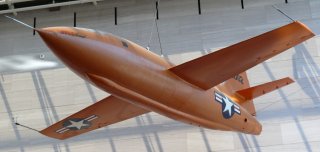These Prototype Planes Push the Boundaries of What's Possible
The U.S. Air Force uses the X-series of planes to gain insights into flight.
Here's What You Need to Remember: Sometimes dangerous, and always insightful, the X-series of planes continue to push the boundaries of what is possible in the air—and now in space.
The X-series of planes are a series of non-production prototype planes that the U.S. Air Force uses to gain insights into flight and push the boundaries of what is possible. Though some of the most well-known and significant X-planes achieved greatness in the 1940s and 1950s, X-planes are still being developed today. Meet some of the greatest X-planes ever built.
The First of an Era: The X-1
In the frenzy of aeronautic advancements after the Second World War, perhaps no airframe contributed more to the understanding of flight more than the Bell X-1, the first of the experimental American X-series.
The X-1 was used to better understand flight characteristics in the transonic range, from Mach 0.8 to Mach 1. Airframes of the era suffered from undesirable flight characteristics in the transonic speed range and were generally unstable and a danger to fly.
The X-1 looks like a bullet—and that’s no accident. The airframe was modeled on a .50 caliber bullet, a supersonic projectile that was stable at Mach 1 and more. The X-1 didn’t have jet engines but got up to speed via rocket engines. It was also dropped from a modified B-50 bomber’s bomb bay so as to conserve as much of the X-1’s fuel as possible for Mach 1+ speeds.
In 1947, the most well-known test pilot in history, Chuck Yeager, became the first man to fly faster than the speed of sound, flying at Mach 1.06 and inching over the sound barrier.
Bell X-2 Starburster
Bell’s next contribution to the X-series broke another barrier—Mach 3. Just as the X-1 increased the depth of knowledge of the transonic range, the X-2 gathered invaluable data on the supersonic range—but was deadly to fly.
Like it’s predecessor, the X-2 was also powered by rocket engines and was dropped out of a modified B-50 bomber’s bay doors, but unlike the X-1, had much more aerodynamically efficient swept wings rather than the X-1’s straight wings. The record-breaking test pilot, Captain Miburn “Mel” Apt would blow past Mach 3 and achieve Mach 3.2 speeds, though the flight cost him his life.
Perhaps due to an instrumentation error, Capitan Apt banked hard while at Mach 3+ speed and lost control of his X-2. Although he was able to eject from the plane via the nose-mounted escape pod, he did not jump out of the pod after separation, possibly knocked unconscious by the massive G forces he experienced. The X-2 program would ultimately cost three test pilots their lives.
X-18
Fast forward a bit in time, and the X-series program would investigate the tilt-rotor designs.
For years, attempts at vertical take-off aircraft had failed badly. Designs generally followed that of conventional airplanes that could point their nose skyward and hover like a helicopter. Though these oddball designs were capable of taking off vertically, they were extremely difficult to handle and only the best and most experienced pilots could fly them. It was hoped that the X-18 could remedy this problem by being easier to handle.
The X-18 looked like a large transport plane, though its entire wing could rotate 90 degrees upward to point its propellers sky-high. After flying slowly upwards, the X-18 would gradually rotate its wing to the forward position and fly horizontally.
Though an improvement on the earlier attempts at vertical takeoff planes, the X-18’s wide wing could not be rotated during high wind conditions, as it acted like a large sail and could cause the airframe to tip over. Though ultimately unsuccessful, the X-18 provided valuable insight into tilt rotor designs and contributed to the V-22 Osprey design—now the backbone of the Marine Corps and Navy’s logistics chain.
Postscript
Sometimes dangerous, and always insightful, the X-series of planes continue to push the boundaries of what is possible in the air—and now in space. These planes continue to impress today. Keep an eye out for more information on the X-series in the future.
Caleb Larson is a multimedia journalist and Defense Writer with The National Interest. He lives in Berlin and covers the intersection of conflict, security, and technology, focusing on American foreign policy, European security, and German society.
This article is being republished due to reader interest.
Image: Ad Meskens, Wikimedia Commons.

